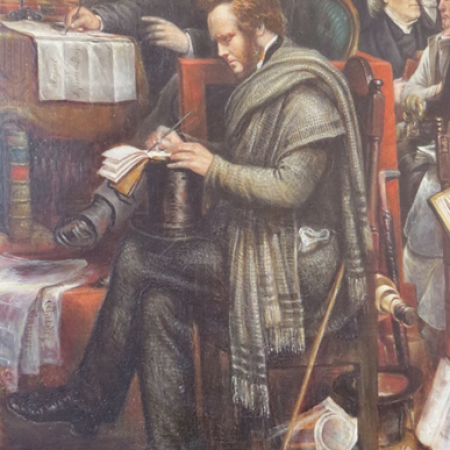I’m grateful to my good friend Paul James-Griffiths of Christian Heritage Edinburgh who most weeks writes an article on some leading Christian in Scotland’s remarkable history. With his permission, I intend to post future articles here.
A shock wave swept through Edinburgh on 24 December, 1856. Hugh Miller, the famous geologist and Free Church of Scotland Christian who had been the editor for The Witness newspaper, had committed suicide. Next to his pistol was a note for his wife: “Dearest Lydia,” it said, “My brain burns. I must have walked; and a fearful dream rises upon me. I cannot bear the horrible thought. God and Father of the Lord Jesus Christ, have mercy upon me. Dearest Lydia, dear children, farewell. My brain burns as the recollection grows. My dear, dear wife farewell. Hugh Miller.” The post mortem report says that he had killed himself because of “the diseased appearance found in the brain”, and that “the act was suicidal under the impulse of insanity.” It would appear that a brain tumour had been the cause of his death.

Hugh Miller, from the Disruption Painting, photo by Paul James-Griffiths
Hugh Miller was one of those personalities who stuck out in the crowd. We see him in the Disruption Painting in the foreground, handsome, and wearing the traditional Scottish rural wrap over his tweed suit, taking notes on his top hat. Although he came from a poor background in Cromarty, he rose to become a foremost influencer in Scotland for both science and the Free Church. He had known grief and loss as a child: firstly, his father had perished at sea when Hugh was only five, then nine years later he lost both of his sisters to fever, leaving him and his mother heartbroken. His two maternal uncles, James and Alexander, stepped in to help their widowed sister. It was through his Uncle Sandy that his passion for the natural world and science was quickened, as they strolled along the seashore studying whatever they could find. There “are professors of Natural History that know less of living nature than was known by Uncle Sandy,” he wrote.
His painful early life led to Hugh being in trouble as his anger sometimes erupted violently. On one occasion he ended up in a brawl with his schoolteacher and was left “mauled in a way that filled” him “with aches and bruises for a full month afterwards.” It was however, the combined work of his best friend John Swanson and Revd Alexander Stewart of Cromarty parish that God used to bring the healing of Christ to this “boy-atheist”. Towards the end of 1825 Hugh gave his life to Christ and found his peace with God.
Whilst he was a stone cutter in Cromarty, he began to collect the fossils he had found, which would eventually find their way into the museums of Scotland. Combining his faith and science he wrote several influential books on geology, The Old Red Sandstone (1841); Footprints of the Creator (1850), and the Testimony of the Rocks (1856). He rejected a traditional view of Genesis and sought to harmonise modern geology with the Bible. For him, the rocks pointed to an earth that was millions of years old, and did not leave evidence of Noah’s global Flood. The six days of creation became epochs of great time, but he did not accept the growing appeal of macro-evolution, which would hit the world with a storm when Charles Darwin published The Origin of Species in 1859.
As evangelicals battled with the moderates over the patronage system that had been thrust on the Presbyterian Church by the government, he sought to uphold the democratic right of the Christians to choose their own leaders. In 1839 he wrote a vital letter to Lord Brougham, entitled, Headship of Christ and the Rights of the Christian People. It was this letter that would be powerfully used to inspire a leading Scottish politician to fight the cause of Christian democracy in Scotland.
In 1840 he was appointed as the first editor of a newspaper called The Witness. In its time this newspaper became the voice of the Free Church, communicating its values and beliefs to the broad spectrum of Scottish society, and would rival the popularity of The Scotsman. Through The Witness newspaper Hugh Miller poured out over 10 million words during his lifetime on faith, science, education, social reforms, and other subjects. When the evangelicals left the Church of Scotland in the 1843 Disruption to establish the Free Church of Scotland, he was the person who covered the events, informing the nation about what was happening. He was so highly respected for his love of science that his name was put forward for the post of Professor of Natural History at the University of Edinburgh in 1854, but it seems that his lack of formal qualifications let him down.
Donald Macleod says of Hugh Miller, “… Chalmers, Cunningham and Candlish could win debates at the Assembly. But it was Miller who took the matter to the country. Without him there would have been no Free Church; and without him the wider Presbyterian family … would not enjoy the spiritual independence it does today.”
“The voice of one crying in the wilderness: ‘Prepare the way of the Lord’” (Isaiah 40:3, NKJV).
